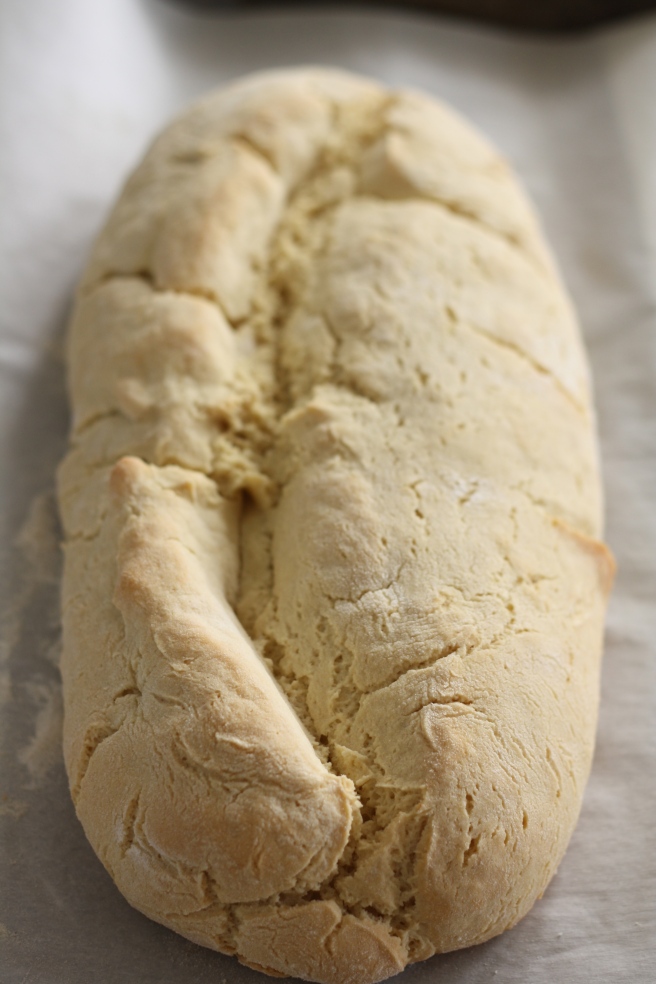Better late than never. We didn’t have enough time to make this bread and develop it like we usually do with a new and unfamiliar recipe. As a result, this is a work in progress. The only alterations we made to the original recipe, were the addition of one egg and the gluten free flour substitutions. We also cut the recipe in half, making only one loaf. Honestly, while the taste was great, we would have liked to see this bread rise much higher and have a lighter consistency. However, we liked the recipe enough to give it a couple more tries, using a different combination of gluten free flours. For those of you that like to experiment along with us, for this batch we used a combination of brown rice, tapioca flour and sweet rice. In future trials, the addition of amaranth and/or teff flour might help create a lighter consistency. We’ll keep you posted.
If you are looking for inspiration, please check out the incredibly delicious looking bread made by Dawn of Dawn’s Simple Sweets, our host this week. Also, don’t forget to check the contributions by all the other bakers in this group.



Congratulations on your work in process. Your bread looks quite delicious and I’ll look forward to hearing more about your adjustments.
Thanks, Hoping to retry this recipe again within the next month. We think it is well worth the effort.
Congrats! And kudos for getting this done!
Thanks, we had fun with this one and will continue to work with it over the next month.
I was wondering if I could substitute some of the AP flour for potato flour in the original recipe…After trying to make injera and totally ruining a crepe pan, I am on the defense line with teff 🙂 Glad to hear that you enjoyed the taste of the bread. Looks great!
Teff, on its own, from our experience doesn’t always work so well. It is best to combine it with other gf flours. Potato flour is heavier and tends to weigh down the dough, if used in too high a proportion to other flours. Generally, we have found that we cannot use more than 2 Tbsp. of potato flour in relation to a cup of gf flour. Perhaps, using gluten flour changes the ratio somewhat.
Inge and Gillian: your bread looks wonderful, it has such a fabulous shape, nice crust and crumb – it will be interesting to see and read what other alternatives you will be able to develop. How interesting to read about all these substitutions for the regular flour, I am always learning something when I visit, for example, I had never heard of teff flour before, but I looked it up and I am certainly intrigued now – have never seen that in my favorite health food store but I will look for it next time I go. I always enjoy your posts so much!
Have a great Thursday!
Overall, we were pretty happy with this bread. However, we would have liked to see it rise a little higher. The taste was great, though. We’ll keep you posted, how our future experiments with the recipe turn out. Have a wonderful weekend, Andrea.
I didn’t get much of a rise either, but I loved the earthy taste from the potato. It will be interesting to see how your experiments go.
Thanks, we are looking forward to developing this recipe further.
Good luck with your loaf. With all the potato I’m sure it was pretty moist, though maybe a bit crumbly.
It was only a little bit crumbly, when it was still warm. Sadly we had to photograph it “on the run” during this time. When it was fully cooled, the bread was very cohesive with a good texture, if a bit dry.
Your first try looks pretty impressive to me. I like the thought of using some teff flour with this – it would make me want to toast the bread up and slather peanut butter all over it (I can’t resist peanut/ teff combo)
We thought that teff might help this bread to rise a little more and also add moisture as well.
Your bread looks beautifully rustic with a moist textured interior.
Thank you. It is a recipe in progress.
I really like the look of this bread..the crust is nice, the color good and the crumb doesn’t look doughy. I sure appreciate all you do for us gluten-free bakers and eaters out in blog land.
Linda
http://coloradofarmlife.wordpress.com
Thanks, Linda. Sometimes we just lack the time to develop recipes for the TWD forum, and do justice to the finalization of our book manuscript. However, TWD has such an inspiring group of enthusiastic people, that we wouldn’t want to miss out on this creative endeavor. Do know, that you can always ask us any and all gluten free related questions. Hope your weekend is going well.
I am looking VERY forward for your new book!!!!
Linda
It was a denser loaf…but truly yummy! Glad you enjoyed it, too!!!
Thank you.
I think that it’s impressive for a first attempt. It has the lovely shape called for in the original recipe.
We will be making it again a few more times to achieve the results we are looking for. While this one was nice, it wasn’t quite there yet.
Looking forward to your experimentations. Loved this bread, chewy and delicious.
Thanks. Keep checking back for future updates.
Your crumb looks soft and chewy! My loaf did not rise a whole lot, but still very tasty. We have been enjoying it for a few days now (from the freezer) toasted. It’s delicious.
Glad you enjoyed this one, Cathleen. We intend to keep playing around with this recipe until we have it just right.